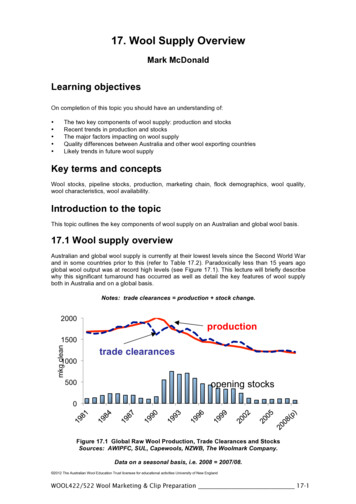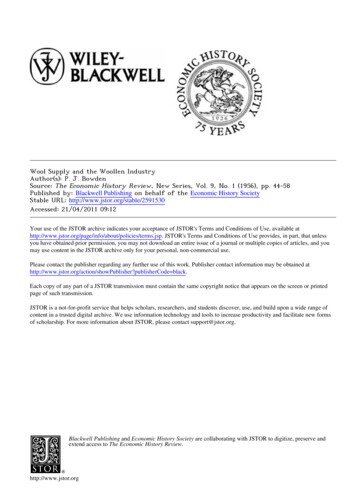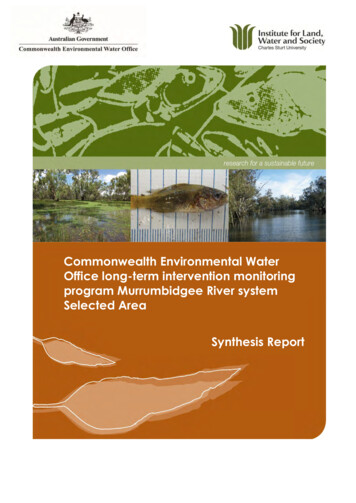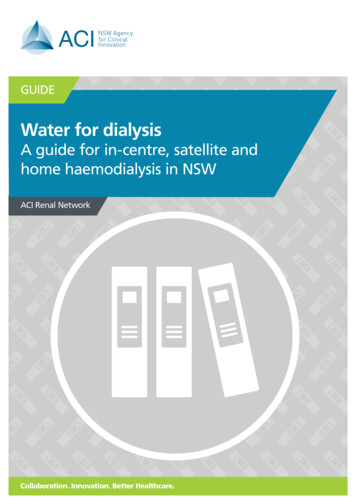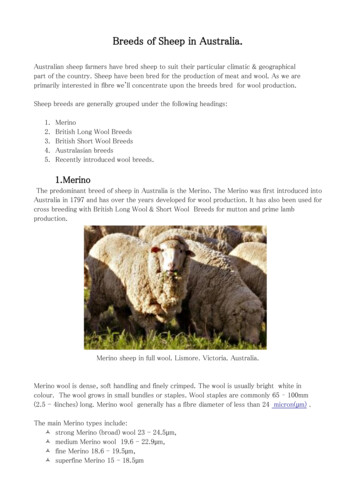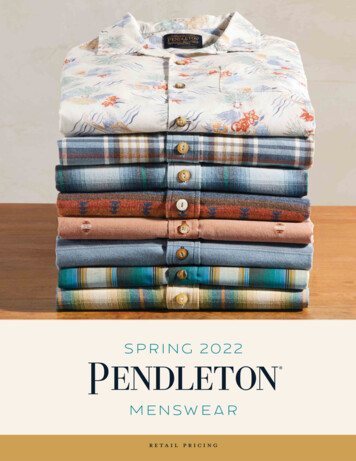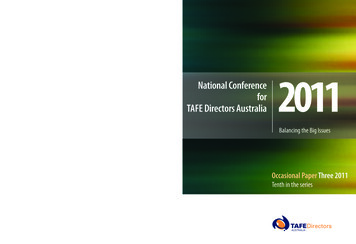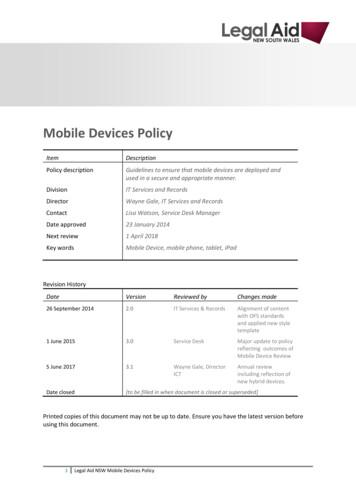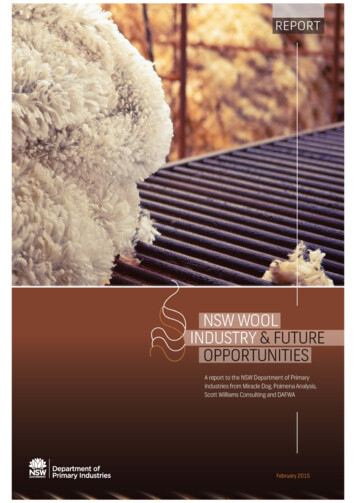
Transcription
Published by the NSW Department of Primary IndustriesNSW Wool Industry and Future OpportunitiesA report to the NSW Department of Primary Industries from Miracle Dog, Poimena Analysis, Scott Williams Consultingand DAFWAAuthors:Russell Pattinson (Miracle Dog)Chris Wilcox (Poimena Analysis)Scott Williams (Scott Williams Consulting)Kimbal Curtis (Department of Agriculture and Food Western Australia)First published February 2015ISBN Photos courtesy of SheepConnect NSW - a project of Australian Wool Innovation Limited and NSW Department of Primary Industries.JTN 13403 State of New South Wales through the Department of Trade and Investment, Regional Infrastructure and Services, 2015.You may copy, distribute and otherwise freely deal with this publication for any purpose, provided that you attribute the NSW Department of PrimaryIndustries as the owner.Disclaimer: The information contained in this publication is based on knowledge and understanding at the time of writing (February 2015). However,because of advances in knowledge, users are reminded of the need to ensure that information upon which they rely is up to date and to check currency ofthe information with the appropriate officer of the Department of Primary Industries or the user’s independent adviser. The report also contains views andrecommendations based on estimates and projections, which are subjective and involve uncertainty. As actual events or results may be different to thoseenvisaged in the report, users should take this into account when making decisions
ContentsContents . iiiList of tables .ivList of figures.ivAbout this report. 1Acknowledgments . 1Situation analysis . 2A snapshot . 2Key implications. 5Findings . 11Recommendations for producers, industry and government. 13Overarching recommendation for all stakeholders: . 14Wool producers should: . 14Wool industry should: . 17NSW Department of Primary Industries should: . 19Appendix 1: Situation analysis . 221. Trends and drivers for the global and Australian wool industry . 222. Sheep and wool – an industry in transition. 323. Wool supply chain . 424. Farm profitability and productivity . 455. Animal health and welfare, the environment and societal expectations . 53Appendix 2: Some brief scenarios . 62Scenario 1: Sheepmeat dominates –‘Hop in for your chop’. 63Scenario 2: Global economy takes off – ‘GFC officially finished’ . 64Scenario 3: Climate change accelerates – ‘It’s just not like it used to be’ . 65Scenario 4: Market changes – ’Casualisation concerns’ . 67Appendix 3: People consulted in the preparation of this report . 68NSW DPI Project Steering Committee: . 68Industry participants: . 68Appendix 4: Outputs from the NSW sheep industry, 2013-14. 69iiiA report to the NSW DPI from Miracle Dog, Poimena Analysis, Scott Williams Consulting and DAFWA
List of tablesTable 1Table 2Table 3Table 4Table 5Micron price differentials (% relative to 21 micron wool) . 27The percentage of (a) ewes mated, (b) sheep and lambs on farms, and (c) farms inNSW that, in 2010-11, produced either Merino lambs only, both Merino and otherbreed lambs, only other breed lambs, or did not mate ewes45 . 38Productivity growth – broadacre enterprises, 1977-78 to 2010-11 (ABARES 2013) . 48Average annual sheep input, output and productivity growth by period (%) (ABARES2013) . 48Results of modelling of climate change impacts on wool production in eight sites inNSW, conducted as part of the Southern Livestock Adaptation 2030 project . 59List of figuresFigure 1Figure 2Figure 3Figure 4Figure 5Figure 6Figure 7Figure 8Figure 9Figure 10Australian wool prices in real and nominal terms . 22Ratio of wool price to price of synthetics and cotton . 23Australian wool production and sheep numbers . 24Australian wool production by state and micron . 25World and Australian production of superfine wool . 25Seasonal effects on Merino micron. 26World trade in wool wovenwear . 29Growth in world economy, population and fibre consumption . 30Per capita apparel wool consumption vs income . 31Number of sheep and lambs (millions), and number of breeding ewes (millions) inNSW (Based on ABS data) . 33Figure 11 Annual wool production (million kg) as reported by the AWI wool productionforecasting committee (AWPFC). . 33Figure 12 Change in composition of the NSW flock (Based on ABARES data) . 34Figure 13 Number of specialist and mixed enterprise sheep farms in NSW (Based on ABARESdata40) . 35Figure 14 Number of sheep per farm for specialist and mixed enterprise sheep farms in NSW(Based on ABARES data40). 35Figure 15 Change in fibre diameter distribution of NSW wool presented for auction, averagedover five year periods. (Based on AWEX auction data. DAFWA analysis) . 36Figure 16 Change in the proportion of wool offered for auction that measured 19.5 µm or finer(Based on AWEX auction data. DAFWA analysis) . 37Figure 17 Converging contributions from wool and sheep meat to the gross value of agriculturalcommodities produced (GVACP) in NSW. Amounts are in nominal dollars (Based onABS data. DAFWA analysis) . 37Figure 18 Age profile of Australian farmers – 1981 and 2011. (ABS 4102.0, 2012) . 40Figure 19 Relative contribution of demographic factors to the decline in the population ofyounger farmers between 1981 and 2011. (after Barr, 2014) . 41Figure 20 Wool supply chain from Australian growers to overseas processors . 43ivA report to NSW DPI from Miracle Dog, Poimena Analysis, Scott Williams Consulting and DAFWA
Figure 21Figure 22Figure 23Figure 24Figure 25Figure 26Figure 27Figure 28Figure 29Figure 30Figure 31NSW wool supply chain . 43Financial performance, all broadacre industries (ABARES, 2014) . 45Financial performance, individual broadacre industries (P. Martin, 2014) . 46Farm business profit – all sheep enterprises NSW . 46Broadacre TFP and Terms of Trade (1977/78 to 2010/11) . 47Gross margin ( /Ha/100mm annual average rainfall) by broadacre enterprise (1998 –2013) . 49Profitability across sheep enterprises at Yass NSW (2009-2014) . 50Profitability of sheep enterprises across locations in 2013 . 51NSW crop area and annual number of livestock units. 51Prices for Australian livestock products . 52Rise in the number of Universities offering animal law courses between 2000 and2007 (‘international’ means ‘outside of the United States’) . 56vA report to NSW DPI from Miracle Dog, Poimena Analysis, Scott Williams Consulting and DAFWA
About this reportThe NSW Government (Department of Primary Industries) commissioned this review to providesome insights into future directions, challenges and opportunities for the State’s wool industry.The review identifies both the potential opportunities and the challenges for the industry over thenext ten years, the implications of these, and then makes recommendations for how New SouthWales (NSW) producers, industry and NSW Government may wish to respond to embrace theopportunities and address the challenges identified.This review was developed by undertaking a relatively brief situation analysis which examined arange of key wool industry parameters – including supply and demand, flock demographics,producer age profiles, productivity and profitability levels – and exploring a range of key industryinfluences such as animal health and welfare, climate variability, conservation andenvironmental attitudes, the carbon economy and predation. Potential trends and implicationswere then developed along with a series of four short scenarios, or illustrations of how the NSWwool industry might look in 2025. It is important to note that the scenarios presented do notrepresent the authors’ views of the future of the wool industry in NSW. Instead, they wereprovided to more closely look at some of the key trends identified in the situation analysis and tostimulate discussion.A consultation paper was prepared and sent to 17 experienced industry participants who weresubsequently interviewed in confidence and their responses collected. This consultation washighly influential in developing the key findings and recommendations within this report.AcknowledgmentsThe project team would like to thank and acknowledge the support and input they receivedduring the preparation of this report. The generous allocation of time and the frank and insightfulviews provided by industry members on the current state of, and future directions for, the woolindustry is greatly appreciated. This input had a significant impact on the recommendationsdeveloped in this report. The team also extends their thanks to the project Steering Committee(Ian Rogan [Chairman], Joe Sullivan, Alex Russell and Ashley White) for their guidance, adviceand comments on the drafts of the various papers, including this final report. The report wasenhanced immeasurably as a result of their feedback.1A report to NSW DPI from Miracle Dog, Poimena Analysis, Scott Williams Consulting and DAFWA
Situation analysisComprehensive desk-top research was undertaken to develop a situation analysis for keyelements of the wool industry in NSW. Five background papers were prepared: Wool supply and demandIndustry demographicsThe wool pipeline and selling system in NSWWool productivity and profitabilityAnimal health and welfare, the environment and societal expectationsA review of a previous scenario planning exercise for the wool industry was also undertaken.The five papers are made available with this report and, as noted above, were compiled into aconsultation paper which was provided to interviewees.This section presents a short summary of the key points arising from the situation analysis andthe implications arising from it.A snapshotThe following is a brief summary (‘snapshot’) of the current status of the wool industry in theworld and Australia generally, and NSW specifically. More detail is provided in Appendix 1 (asindicated by the page number against each point) and in the background papers.Wool’s place as a world textile 1Australian (and therefore NSW) wool competes against an increasing volume of otherfibres used in apparel. (p 22)Wool production globally and in Australia has been falling due to low prices andperceived higher profitability of other enterprises, notably cropping and lamb production.(p 23)NSW has the largest sheep population and is the largest wool-producing Australian state.If it were a country it would be the world’s fourth-largest supplier. (p 24)The Australian (and NSW) wool clip has been trending genetically finer since the early1990s which, combined with the influence of drought and dry conditions in 2012 and2013, has led to an over-supply of and a reduction in the premium for superfine 1 wool. (p25)Over the last two decades, China has become the dominant buyer of Australian greasywool. (p 27)China now dominates global exports of wool textiles with the US, UK, Japan and Italybeing the largest importers. (p 28)Based on global trade data, knitwear and men’s suits, jackets and trousers provide asolid foundation for wool use, while wool’s volume and share in most women’swovenwear has been eroded by price competition and a trend to ‘fast fashion’ retailing.(p 28)Casualisation might erode sales of traditional high-value woven wool wear, although woolknitwear could benefit. (p 28)Superfine wool is defined as being 18.5 micron and finer.2A report to NSW DPI from Miracle Dog, Poimena Analysis, Scott Williams Consulting and DAFWA
Global growth in textile demand (especially wool products) is driven by population andincomes. (p 29)With little prospect for growth in wool supply, the opportunity lies in increased valuedemand for wool products, including benefiting from wool’s advantage as a natural,sustainably-grown fibre. (p 30)Casualisation and active leisure wear are a natural fit for Australia’s growing superfinewool component. (p 31)Despite tougher environmental regulations and rising labour costs, China is expected toremain the main processor of Australian wool and the China Australia Free TradeAgreement (FTA) will (marginally) assist this relationship. (p 31)Increasing global demand for food is expected to constrain expansion of wool productionin NSW and Australia. (p 32)Flock size, production and producers In 2014 the NSW flock comprised 27 million sheep, including 15 million breeding ewes,producing 125 million kg of greasy shorn wool in 2013/14. (p 33)Breeding ewes and lambs have increased as a proportion of the flock at the expense ofwethers as sheep meat rises in importance. (p 33)Between 1991 and 2000, the number of specialist sheep producers declined as they quitsheep or moved into cropping, and then from 2000, mixed enterprise producersaggregated farms without increasing flock size. (p 34)Lamb production has replaced mutton turn-off resulting in an increase in product quality(and value). (p 35)Low wool prices have provided an incentive for producers to go finer, or to expand theirarea under crop. (p 35)Recently there have been depressed premiums for superfine wool as the supply ofsuperfine wool has exceeded demand. (p 36)The transition from a wool-driven sheep industry to a dual-product wool plus lambindustry is reflected in the converging value of each commodity to NSW. (p 37)Despite the increased importance of lamb production, Merino ewes remain the core ofthe flock. (p 38)Recent increases in marking rates support the production of lamb and are driving anincrease in flock efficiency. (p 38)The sheep industry is highly export-dependent with two-thirds of sheep meat productionexported and most wool exported. (p 39)Over three decades to 2011, the number of farmers in Australia declined 40% while themedian age increased by nine years to 53. (p 39)The factors driving the decline in the number of young farmers are farm aggregation,declining participation of young people, and increased entry / decreased exit of olderworkers. (p 40)Between the collapse of the Reserve Price Scheme and the disposal of the stockpile, thenumber of young entrants halved and subsequent sheep industry performance has failedto reverse this pattern. (p 41)There is a significant change continuing in the provision of support services (especiallyextension and advice) for farmers – moving from the public to the private sector. (p 42)3A report to NSW DPI from Miracle Dog, Poimena Analysis, Scott Williams Consulting and DAFWA
Supply chain and selling system Apart from compliance with government regulation, the wool supply chain, including theselling system, is totally driven by commercial imperatives. (p 42)Eighty-five to 90% of Australia’s wool is sold at auction, with NSW wool predominantlysold at auction centres either in Yennora (Sydney) or in Melbourne. (p 44)Cotton is sold very differently to wool as a result of the vastly greater financial risk facingcotton producers. (p 44)There were 23 auction brokers selling to 37 buyers in NSW in 2013/14, although 15buyers accounted for 85% of wool sold. (p 44)The number of bales sold through Sydney was equivalent to two-thirds of the salesthrough Melbourne in 2013/14. (p 45)Enterprise productivity and profitability Many broadacre farms, including sheep enterprises, have on average experienced low ornegative profitability over the last decade. (p 46)Wool tends to be only a component of a broadacre enterprise and often a smallproportion of farm receipts. (p 47)Terms of trade for broadacre farms are falling and are likely to continue doing so. (p 47)Wool industry productivity gains have, on average, been lower than those of otherbroadacre enterprises, making the impact on terms of trade even more pronounced. (p48)The industry needs to better manage its declining terms of trade by increasingproductivity and / or increasing the value of the product. (p 48)Relative profitability between broadacre enterprises depends on commodity prices andseasonal conditions – wool may not be the most profitable enterprise but returns fromwool do tend to be less volatile over time. (p 49)There is big variation in profitability between wool enterprises, with some wool producersachieving good profitability. (p 52)Since the 1990s, broadacre producers in the sheep / cereal zone and even high rainfallzone have shifted away from sheep to more cropping. (p 50)Sheep may have a greater role in the relatively higher-risk, lower-rainfall, mixed farmingareas. (p 52)ABARES predicts that future wool price trends will be outstripped by increases in pricesfor lamb and mutton, on par with beef, but better than wheat. (p 52)Information and investment are required to grow production levels and quality. (p 53)Animal health and welfare, the environment and societal expectations Increasingly, society expects food and fibre production to meet its ethical standards, notjust those adopted to meet the supply chain’s requirements. (p 53)Animal health management remains a significant cost to livestock production and this isexpected to continue despite incremental improvements in treatments. (p 53)Animal health has the potential to throw up particularly disruptive events such as exoticdisease outbreaks or food safety scares. (p 54)Predation by wild dogs is a growing threat with serious productivity, social andenvironmental impacts in affected regions. (p 55)4A report to NSW DPI from Miracle Dog, Poimena Analysis, Scott Williams Consulting and DAFWA
The world is gradually changing its attitudes about how animals should be treated byhumans. (p 55)Animal welfare regulations are becoming more based upon welfare science than‘accepted industry practice’. (p 56)Retailers market to the consumer’s desire for ethical animal production and may imposeproduction standards on producers with little consultation. (p 57)The wool industry continues to invest in improving production practices to meetcommunity expectations. (p 57)Chemicals are important inputs for wool production but chemical use is under constantscrutiny. (p 58)Climate change has the potential to affect productivity but the impact is unlikely to beuniform across geographical regions. (p 58)Adaptation options may mitigate some of the impacts of climate change, but some ofthese mitigation options are already ‘factored in’ to address declining terms of trade asthey are current best-practice. (p 59)Government policy responses to climate change in coming years will also affect the woolindustry. (p 60)Society will continue to demand ‘environmental services’ from farmers, but may have tocontribute to the cost of these. (p 60)Key implicationsThere are a number of key implications from the situation analysis for NSW wool producers, theNSW wool industry and the NSW Government:Global economic conditions and incomes are the major driver of demandprospects The long term prospects for the demand for Australian and NSW wool will hinge most on globaleconomic conditions and income growth, and less on the relative volume of wool productioncompared with the production of other textile fibres or on the relative price of wool comparedwith these other fibres. which means consumer requirements, clothing styles and retail trends will becrucial for the type of wool used The consumer requirements for wool include quality garments at moderate price levels for theupper-middle retail market and luxury garments at higher price points. There is no clear-cutevidence that demand for worsted men’s suits and jackets and trousers has waned in recentyears in spite of the casualisation trend. Demand for this business wear should thereforecontinue to be a mainstay of demand for Australian wool. This means there should still be soliddemand for fine Merino fleece wool of around 85 mm length with good tensile strength.There is likely to be increased demand for active leisurewear (next-to-skin wear) and casualgarments (knitwear and unstructured jackets and trousers). Wool that is best placed to capitaliseon the growth in active leisurewear is fine wool of 19 microns and finer, and preferably 18microns or even less (superfine wool). The wool used for these products requires good strengthand length, so the preference is mainly for fleece wool. Fine wool is also favoured for lightweightknitwear, and yarn used for this market requires raw wool that has moderate tensile strengthwith an average Hauteur in the top of 58-65mm. This means the raw wool purchased can be ablend of fleece and pieces / bellies and prem shorn.5A report to NSW DPI from Miracle Dog, Poimena Analysis, Scott Williams Consulting and DAFWA
The development of the ‘fast fashion’ retail sector (exemplified by retailers such as Zara, H&Mand Uniqlo) has contributed to a steady decline in wool use in most women’s wear, with theexception of overcoats for colder weather. This has not taken hold in men’s wear to the samedegree, although the risk is that it may do so in the future. and demand for superfine wool has risen due to these requirements.Superfine wool premiums have been low, largely due to a sharp increase in production ofsuperfine wool, not because of a collapse in demand. Demand for most categories of superfinewool has actually increased. The premium for superfine wool is likely to return towards the 10year average once the short-term, drought-induced aspect of the increased superfine woolproduction wanes, although the long-term trend towards finer wool will mean higher productionrelative to a decade ago. The increased demand for superfine wool and the potential growth indemand for garments which use superfine wool (such as active leisurewear) justifies a continued(but not increased) emphasis on producing sound superfine wool. This may not be traditionalAustralian superfine wool (‘spinners’ style) but more general ‘good topmaking’ styles.In contrast, the very low level of production of wool of 21 to 24 microns has been the reason forthe better prices across this range. Demand for this wool does not appear to have increased. Aswell, this wool faces the most competition from man-made fibres (as it can be substituted for thiswool in blends). A significant increase in production of this wool is likely to result in markedlylower prices.Consumers are more demanding of environmentally sustainable products.The rising consumer interest in the environmental and animal welfare impacts of products willinfluence both the direct demand for wool products and government regulation. Consumers willput the provenance of garments under the microscope, wanting to know the source of the rawfibre to ensure that it is produced sustainably with low environmental impact and minimal impacton the welfare of animals. Products which can prove their environmental and welfare credentialswill see the strongest demand.Some retailers are responding to this demand by developing accreditation throughout the supplychain back to the raw wool, and this trend is expected to grow in the next ten years. The woolindustry will need to strengthen existing systems (such as the mulesing status declaration on theNational Wool Declaration) or develop and adopt new systems.Governments may also respond through increased regulatory requirements on all involved in thesupply chain, from producers to garment makers and retailers.China will remain the major processor of Australian wool China will remain the major processor of wool and manufacturer of wool products over the nextten years, in spite of some challenges in the near term, notably from new environmental controlsand tighter credit availability. It is highly unlikely that early stage processing will return toAustralia in any significant way, in part because of the size of China’s industry and in part due tonew early stage processing plants which have been established in the past 2-3 years elsewhere,such as Egypt and Malaysia. and will further develop as a major consumer market for wool.In the longer term, the transition of China’s economy to a more mature one – based more onconsumer demand, branded and higher quality products and the services industry – willpotentially be a major benefit for wool with growth in the purchases of wool products by Chineseconsumers. However, this growth is more likely to be for more casual styles of clothing, including6A report to NSW DPI from Miracle Dog, Poimena Analysis, Scott Williams Consulting and DAFWA
business casual wear, rather than formal wear. There will still be some demand for formalbusiness attire, but not for everyday office wear.Australia and NSW wool production, which has fallen in the past two decades, has amajor influence on the world wool market Developments in Australia and NSW have a major influence on world supply and price of wool,due to their size and importance in the global production of apparel wool.Wool production in both Australia and NSW has fallen over the past two decades to 90 year lowsdue in part to the poor profitability of wool enterprises compared with other agriculturalenterprises. Recently this has been most notable for superfine wool where micron pricepremiums have reduced dramatically. As well, productivity increases for the sheep and woolindustry have been poor in the past, although some turn-around may be evident more recently. Itis important to note, however, that over the last two decades, improvement in wool productionhas focussed on improving product quality (principally by reducing fibre diameter) rather thanquantity.Furthermore, sheep producers have increasingly shifted their focus from wool to meatproduction – not abandoning wool but moving from a sole wool focus to mixed farmingenterprises, with wool being just one of their diversified product lines. and production is likel
A snapshot The following is a brief summary ('snapshot') of the current status of the wool industry in the world and Australia generally, and NSW specifically. More detail is provided in Appendix 1 (as indicated by the page number against each point) and in the background papers.
